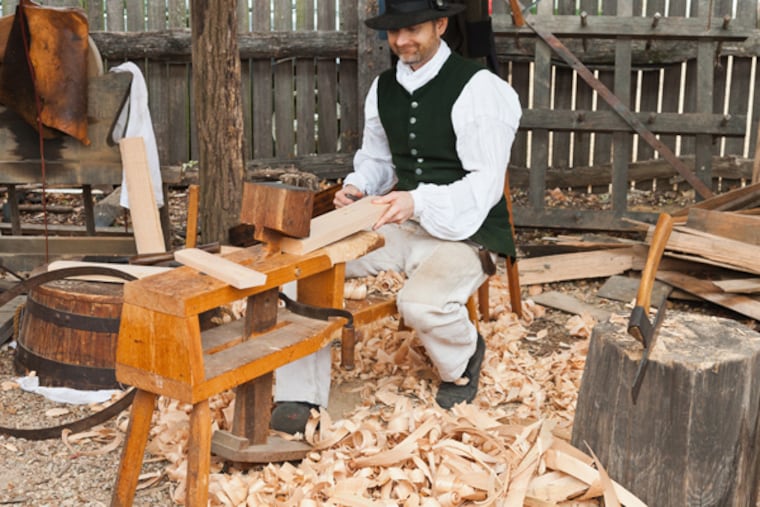From N.J., authentic wood for colonial shingles
When it comes to preserving and reconstructing the historic buildings of Colonial Williamsburg in Virginia, Garland Wood doesn't cut corners.

When it comes to preserving and reconstructing the historic buildings of Colonial Williamsburg in Virginia, Garland Wood doesn't cut corners.
The master carpenter builds houses, sheds, and barns the way the colonists did - from the ground up, using the same tools.
But he's had problems finding one of the key building materials: Atlantic white cedar, a light, long-lasting, rot-resistant wood that colonists often used for shingles.
This year, Wood found what he needed in New Jersey, enough to eventually put an authentic 18th-century-style roof on the $1 million reconstructed Market House in the center of town.
The cedars - most of them from Double Trouble State Park in Berkeley Township, Ocean County - were knocked over by Hurricane Sandy in 2012 and are being retrieved by Advanced Forestry Solutions of Pittsgrove, Salem County.
Their delivery may lead to future North-South cedar sales because the storm felled thousands of trees across South Jersey, officials in both states said.
"We have 100 more buildings to build here, big and small, and we will continue to need cedars," said Wood, who has worked for the Colonial Williamsburg Foundation for 30 years. "They're being salvaged from the hurricane, and I can't think of a better use than making them part of an 18th-century roof of the Market House."
Atlantic white cedars covered about 500,000 acres along the East Coast and Gulf of Mexico during colonial times.
By some estimates, they now may occupy less than 50,000 acres, largely because of logging, development, and storms over the last three centuries.
The wood has been used since the first settlers arrived, for shingles, siding, and boats. Independence Hall is roofed with cedar shingles.
The Williamsburg project "is the outright preservation of our heritage, using wood products that the colonists actually used," said certified forester Bob Williams, vice president of forestry operations at Land Dimensions Engineering in Glassboro. "Any time you connect the restoration of natural resources to the preservation of cultural resources, that's a win-win."
The retrieval of the cedars from wetlands at Double Trouble State Park is the first step in the restoration of the forest. It got underway in January and is being overseen by the state Department of Environmental Protection's Forestry Services. The 70-year-old trees are being removed to make way for new growth.
"I'll put the logs on a trailer and ship them" to Williamsburg, said Colin McLaughlin, operations manager for Advanced Forestry Solutions. "The first load will get there in about a month.
"They'll get a little bit at a time," he said. "Then, they'll hand-saw and hand-split them there."
McLaughlin's large, tank-like harvester clamps onto a tree near the ground, slices through it with a hydraulic chain saw, then strips off the branches in a series of quick moves.
"It's good for the health of the forest" to make way for new cedars, said McLaughlin, who hopes to sell more trees from the park and private lands. "So many people outside of the Williamsburg corridor have been looking for cedar shingles, so this may lead to other business."
Advanced Forestry Solutions got the Double Trouble job from the state with a bid of $15,100, McLaughlin said. Williamsburg expects to use at least 40 logs at a cost of tens of thousands of dollars, Wood said.
The woodworking craftsmen of the colonial town will turn the logs into 3/4-inch-thick shingles measuring about five by 18 inches. They will be used to roof a faithful reconstruction of the open 1757 Market House, midway between the Capitol and the College of William and Mary.
The building - a wooden structure on a brick base measuring 20 by 40 feet - is being designed and materials are being collected for its construction in 2015. The site was a center of community life, with auctions and market sales, in the 18th and 19th centuries.
"We practice the period tradition of construction," Wood said. "We build the buildings while people watch, and getting the right wood is critical to what we do.
"When it's finished, we will build tables and butcher blocks like they would've had there. It will be a functioning market where people can visit and buy things."
Williamsburg has 88 restored original buildings and 400 reconstructed buildings, Wood said. About 75 families live in the town.
"Virginia and New Jersey had a lot in common in the 1770s," when colonists united against Britain, Wood said. "It wasn't until the New Jersey boys in blue uniforms [came to Virginia during the Civil War] that we started to have trouble - but everybody is getting along now.
"We're excited about the [cedar] opportunity in New Jersey," he said. "We'll begin making materials for the Market House next month."